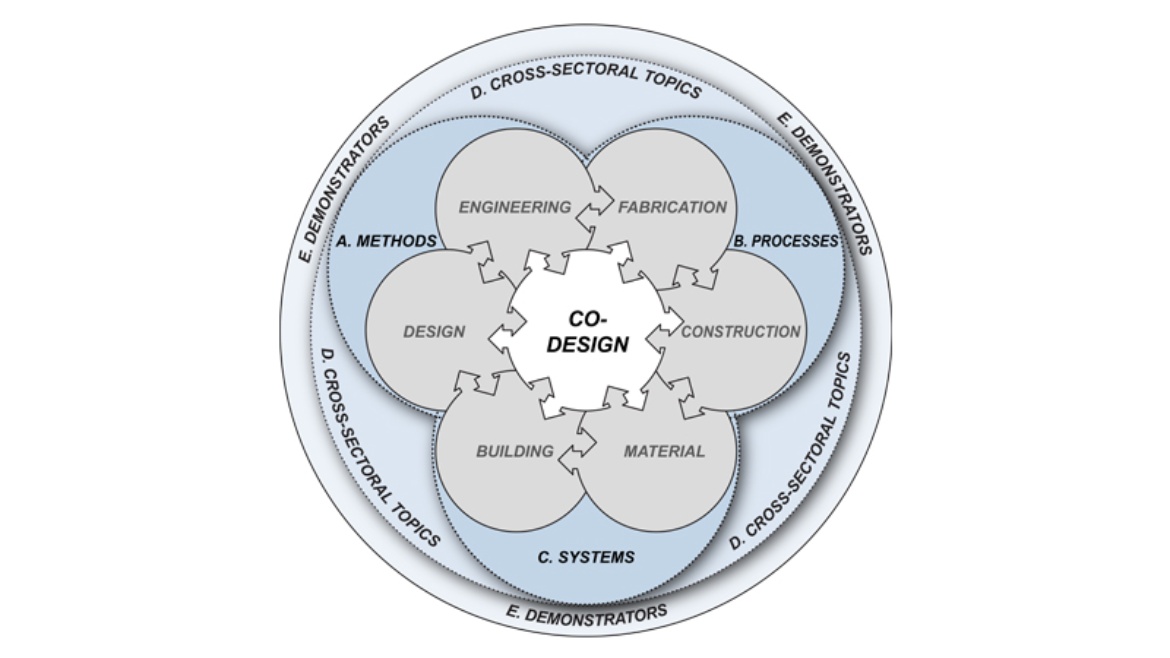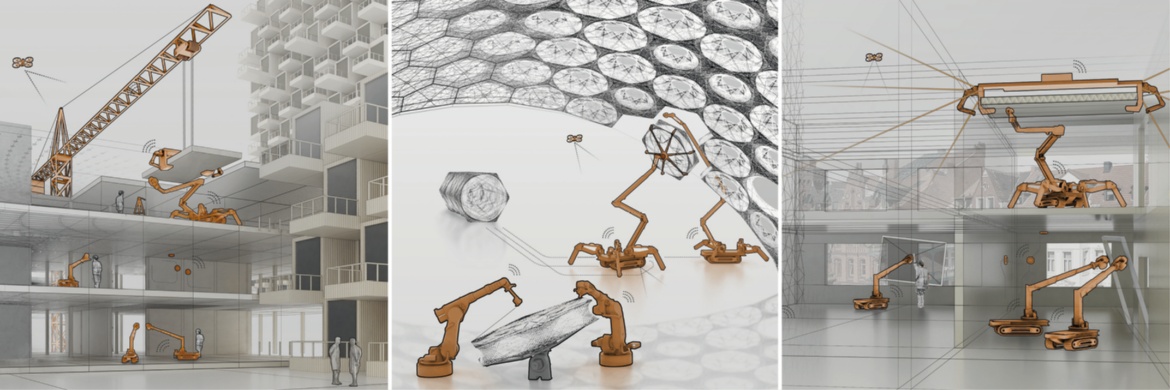The University of Stuttgart established its new Cluster of Excellence on Integrative Computational Design and Construction for Architecture in 2019. With an initial funding period of seven years, a Cluster of Excellence is the most significant and substantial grant awarded by the German Research Foundation (DFG). For the very first time, a Cluster of Excellence has been awarded to the field of Architecture. It will contribute to establishing an internationally visible research center.
Research Relevance
The urgent need to rethink design and construction in architecture
Humans spend 87% of their lives in buildings. Architecture is the habitat of mankind. Therefore, it is of central ecological, economic, social and cultural relevance. This generates significant challenges: By 2050, 2.6 billion people will require new housing, work places and infrastructure due to rapid urbanisation and population growth. For example, in Germany alone, 400,000 new residential units and related commercial and public buildings need to be constructed every year, but only half of this demand can currently be met. The productivity of the building sector has been stagnating since the 1990s, and it has struggled to complete major buildings in time and on budget.
Moreover, already in its present state, the building industry is responsible for approximately 40% of global resource consumption, 40% of energy use, and 50% of global waste. It is evident that mere incremental improvements to established approaches to design and construction will not be able to meet these severe challenges. Instead, new approaches are urgently required.
At the same time, the building industry constitutes the largest industry globally, offering enormous growth potential. Digital technologies make it possible to address these challenges and opportunities in novel ways. However, their adoption is slow in the building industry, and typically only focused on isolated aspects of the building process due to the fragmented nature of the construction sector and a compartmentalised research culture. Thus, innovation is limited to decoupled research insights and incremental advancements. The full potential of digital technologies remains underutilised.
Research Mission
Shaping the future of architecture and the building industry
The vision of the Cluster of Excellence Integrative Computational Design and Construction for Architecture (IntCDC) is to harness the full potential of digital technologies in order to rethink design, fabrication and construction based on integration and interdisciplinarity, with the goal of enabling game-changing innovation in the building sector as it can only occur through highly integrative fundamental research in an interdisciplinary, large-scale research undertaking.
The Cluster aims to lay the methodological foundations for a profound rethinking of the design and building process and related building systems by adopting an integrative computational approach based on interdisciplinary research encompassing architecture, structural engineering, building physics, engineering geodesy, manufacturing and system engineering, computer science and robotics, social sciences and humanities. We aim to bundle the internationally recognised competencies in these fields of the University of Stuttgart and the Max Planck Institute for Intelligent Systems to accomplish our research mission.
The Cluster’s Industry Consortium will ensure direct knowledge exchange, transfer and rapid impact. Taking into account the significant difference between the building industry and other industries, we will tackle the related key challenges of achieving a higher level of integration, performance and adaptability, and we will address the most important building typologies of multi-storey buildings, long-span buildings, and the densification of urban areas.
The Cluster’s broad methodological insights and interdisciplinary findings are expected to result in comprehensive approaches to harnessing digital technologies, which will help to address the ecological, economic and social challenges that current incremental approaches cannot solve.
We envision IntCDC to significantly shape the future of architecture and the building industry through a higher-level integration of computational design and engineering methods, effective cyber-physical (tightly interlinked computational and material) robotic construction processes and new forms of human-machine collaboration, efficient and sustainable next-generation building systems, and socio-cultural and ethical reflection. Thus, the Cluster will have significant impact on creating the conditions required for a liveable and sustainable future built environment, high-quality yet affordable architecture and a novel digital building culture.
Research Programme
Towards truly integrative computational design and construction
There is a real need, urgency but also opportunity to rethink design and construction in a comprehensive manner, as we can simply not afford to continue building in the way we do now. The lack of digitisation in construction, and the related lack of productivity, together with the significant lack of sustainability can be summarized as a serious innovation shortcoming in the building sector. However, advancing building construction is a complex task and requires profound new methods, as architecture and construction differs substantially from other industries, due to the site-, culture- and context specificity and one-off character of buildings.
Integrative Research Approach: Co-Design of A. Methods, B. Processes, C. Systems, D. Cross-Sectoral Topics, E. Demonstrators
A major obstacle for innovation in architecture and the building sector is the compartementalised nature of research on digital technologies, which separately addresses either the area of design and engineering methods, or fabrication and construction processes, or material and building systems. In order to explore the full potential of computation for ground-breaking advancement, it is vital to adopt an integrative research approach that innovates across all these areas simultaneously. Our goal is to develop an overarching methodology of “co-design” of methods, processes and systems, cross-sectoral socio-cultural studies and building demonstrators.
In line with our goals, the research programme operates across three structural instruments:
(1) The Research Areas are derived from our research approach as a content-oriented framework:
A. Methods: Truly integrative computational design and engineering methods
B. Processes: Robotic cyber-physical fabrication and construction processes
C. Systems: Genuinely digital, next-generation material and building systems
D. Cross Sectoral: Inclusive and sustainable innovation with critical reflection
E. Demonstrators: Rapid turn from visionary research to architectural application
(2) The Research Units are the Cluster’s collaborative work units that ensure both highly interdisciplinary insights and significant domain-specific fundamental research advancement. Their work programmes span all research areas and contribute to meeting our overall goals.
I. Architecture advances computational design methods and integrates IntCDC’s impact on architectural systems and typologies, and its effect on an emerging digital building culture.
II. Structural Engineering, Building Physics and Geodesy develops next generation building systems engineered for robotic construction based on 4D modelling and monitoring.
III. Manufacturing and Systems Engineering unites cyber-physical off-site fabrication and on-site robotic construction for IntCDC building processes, incl. human-machine cooperation.
IV. Computer Science and Robotics develops methodologies for IntCDC’s data integration, artificial intelligence, interactive exploration, autonomous as well as collaborative robotics.
V. Humanities and Social Sciences aims to clarify the preconditions and requirements for the social embedding of IntCDC, its ethical implications and its historical perspective.
(3) The Research Networks provide flexible, thematic vehicles for the research units to work under one theme and to move towards joint building demonstrators. They address shared key research challenges in an inter-disciplinary manner, and also ensure that the work is relevant to the most important architectural applications:
Research Network 1 (RN 1) will address the co-design-based development of methods, processes and systems for the most common architectural type: multi-storey buildings, such as residential and office buildings, which pose the challenge of a high level of integration.
Research Network 2 (RN 2) will focus on long-span buildings, such as large public, cultural, and infrastructural buildings. It serves as a challenge for a high level of performance, which is decisive for related architectural articulation, economic feasibility and environmental impact.
Research Network 3 (RN 3) investigates the densification of existing building stock, which consti- tutes a central task for cities in the developed world. Construction between or on top of existing buildings in dense urban areas poses the challenge of a high level of adaptability.
RN 1: IntCDC for multi-storey buildings (left), RN 2: IntCDC for long-span buildings (center), RN 3: IntCDC for existing building stock extension (right)
Research Environment
Creating long-term excellence, inclusiveness and diversity
We strive to build a diverse and inclusive research environment and thus strongly support equal opportunity across gender, ethnicity, nationality, physical ability and social background for all career stages. We aim to attract and train the next generation of leaders in the field of IntCDC and thus intensely promote early career researchers and foster early academic independence. The Cluster will be home to several new professorships, multiple independent junior research groups, almost 100 doctoral and postdoctoral researchers, as well as many international exchange researchers. We will establish a Graduate School of Advanced Research in Integrative Computational Design and Construction, which offers individualised training, “blue sky” grants, international mobility grants and industry secondments. Our researchers will also engage IntCDC’s findings in multifaceted teaching opportunities.
Our International Research Programme with leading partners (including, amongst others, Harvard, MIT, ETH, UCL, Cornell, CITA, Tongji University, Imperial College, TU Vienna, etc.) will reinforce the Cluster’s standing as a global hub for knowledge exchange. Considering IntCDC’s high potential of strongly advancing the building industry, we will intensely engage our Industry Consortium and our demonstrators to ensure research guidance and rapid knowledge transfer. IntCDC also provides ample entrepreneurial opportunities, which we will support through special training, promotion of an active start-up culture and the university’s knowledge transfer funding.
The university will build a new Large Scale Construction Robotics Laboratory at a central campus location, which will facilitate our research programme and building demonstrators. It will provide an indoor area for our Instrumentation Platform for Off-Site Prefabrication, which will be seamlessly connected to an outdoor building site area for our Instrumentation Platforms for On-Site Construction and for On-Site Fabrication, Fitting and Finishing. This lab, which covers the entire cyber-physical building process, will constitute a globally unique research infrastructure and a significant long-term contribution to reinforce the university's leading role in Integrative Computational Design and Construction.
Research Position
An excellent starting point for an international centre in an emerging field
The University of Stuttgart is uniquely positioned to take on the Cluster’s research challenges. It has a longstanding tradition and enjoys high international visibility as a centre for innovation in the design, engineering and construction of architecture and the built environment. The academic work of pioneering architects and engineers has generated research insights with extraordinary international impact, resulting in some truly iconic buildings of the 20th century, and earning the highest honours in the discipline, e.g. Frei Otto receiving the Pritzker Prize in 2015. Related seminal DFG Collaborative Research Centres such as SFB 64 (1971-1985) and SFB 230 (1984-1995) have established a unique research culture and positioned the University of Stuttgart as a global player in the field. Today, this enduring research excellence is reflected in two DFG Collaborative Research Centres: SFB/TRR 141 and SFB 1244. This constitutes an exceptional position of research excellence in this domain in Germany and serves as an ideal starting point for the Cluster’s highly innovative research.
Research Team
Shaping the future of architecture and the building industry
The Principal Investigators and Participating Researchers of the Cluster represent the breadth of scientific excellence across seven faculties of the University of Stuttgart and the Max Planck Institute for Intelligent Systems. This interdisciplinary team of researchers with international standing in the respective disciplines is well-balanced to meet the Cluster’s goals. The University of Stuttgart will also establish four dedicated new professorships especially for the Cluster, and an international visiting professorship to attract renowned scientists to advance our research and to forge further partnerships.
In summary, we aim to build on the University of Stuttgart’s excellence in integrating architecture and engineering to create a globally visible research centre with a unique research facility. We expect IntCDC to significantly shape the future of architecture and the building industry.



